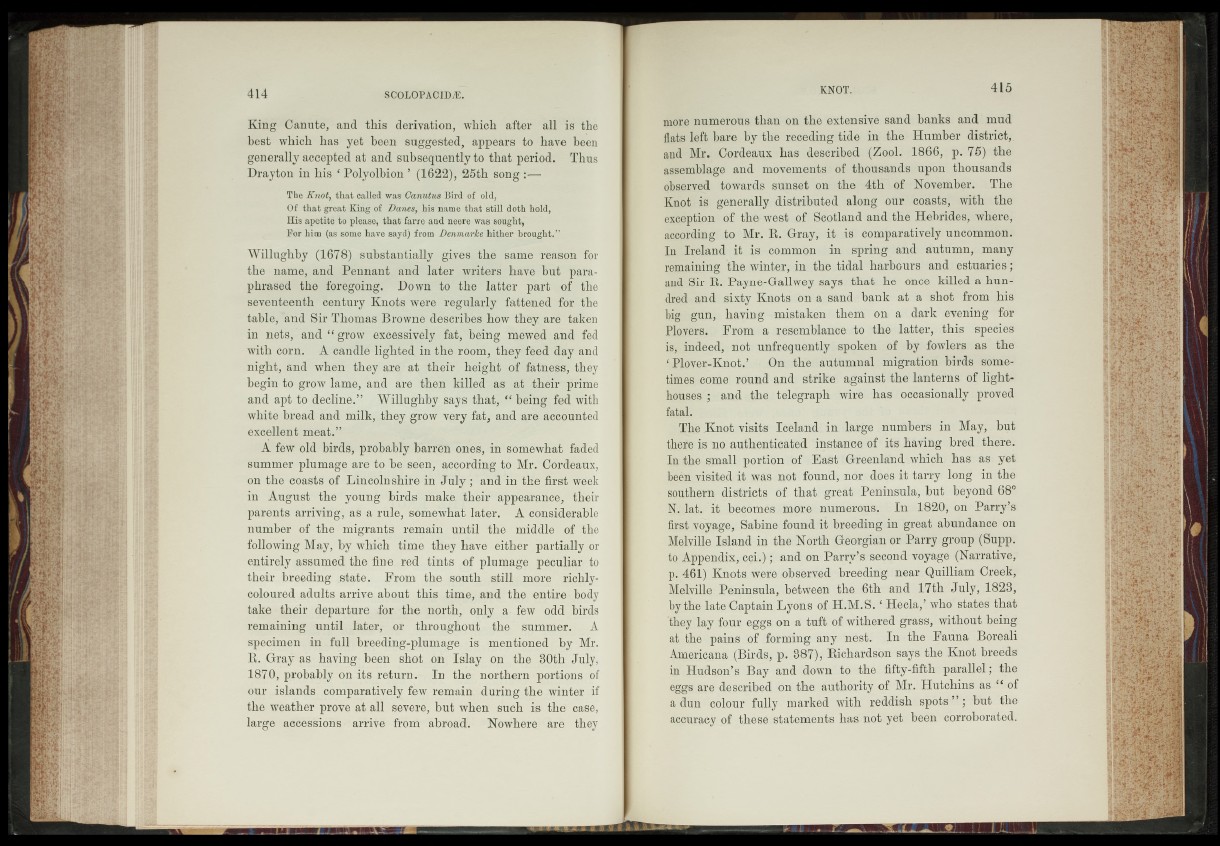
King Canute, and this derivation, which after all is'the
best which has yet been suggested, appears to have been
generally accepted at and subsequently to that period. Thus
Drayton in his * Polyolbion ’ (1622), 25th song
The Knot, that called was Canutus Bird of'old,
Of that great King of Danes, hie name that still doth hold,
His apetite to please, that farre and neere was songlit^
For him (as soihe have sayd) from Dehmarlce hither brought.”
Willughby (1678) substantially gives the same reason for
the name, and Pennant, and later writers have but paraphrased
the foregoing. Down to the litter part of', the
seventeenth century Knots were regularly fattened" for the
table, “and Sir Thomas Browne describes how they are' t&ken
in nets, and “ grow "excessively;!fat, being mewed and fed
with corn. A candle lighted in the room, they^ed day and
night, and when they are at their- height of fatness, pily
begin to grow lame, and are then killed" as at* their "prime
and apt to decline.” Willughby says that, “ being fed/with
white bread and milk, they grow very fat, and are uccoifnted
excellent meat.”
A few old birds, probably barren ones, in somewhat faded
summer plumage afe'toho seen, according to Mr.’Cbrdfeaux,
on the coasts of Lincmnmife an July ; and in the first flfek
in August the young- birds make^heir appearancf^flleir
parents arriving, as-a rule, somewhat later. - A considerable
number of the migrants remain until the 1 twiddle of the
following May, by which time -they have either partially or
entirely ^assumed the fine red tints ce>£ plunjage peculiar to
their breeding .state., Emm the so,utKr,stil^mfi;©'’ richly-
cploured adults arrive about this time, and the, entire^body
take jhei^ departure for the north, opiy a ,fe^w‘ pdd mirds
remaining until later,» or throughput-fth.er sem-mer. i,A
specimen, in - full- breeding-plumagej*J|s mentioned:-by Mr.
R. Gray as ■ haying? bepn shot on_ Islay. on thp .80th July,
1870, probably on it$ return..- In the- nortferp ^portions of
■3j|gr islands comparatively few remain, during the ..winter, if
the weather prole at all severe, but when such is the' case,
large accessions arrive fronk abroad; - Nowhere.* arfe they
more numerous than on. the extensive sand banks and mud
flats left bare by the receding tide in the Humber district,,
and Mr. Cordeaux has described (Zaol. 1866, p. 75); the
assemblage and movements • of thousands upon thousands
observed: '-.towards sunset on the 4th of -^November. The
Knot is- generally distributed, along our coasts; with ..the*
exception of the^west :ofi Scotland and the. Hebrides, where,
according to Mr> R. Gray, it ,is comparatively uncommon.
In "Ireland common ;in spring-and; autumn, many
remaining the winter, -in^the tidal harbours and estuaries#;;
and Sir R. Payne.-Gallwey says that:.:he. once, killed a hundred
and sixty Knots-on a sand bank at a shot from his-
big,f -gun, haying -mistaken - them ©in a dark’ evening
Ployers. From a fpsemblance,;to the latter, this species,
is,indeed, not unfrequently$spoken of by fowlers as the
| Plover-Knot.’ On the autumnal migration- birds some-
times comerrp.und and strike against the lanterfis of lighthouses
; - and etbe;’t#%raplv; wire; has occasionally ..proved,
fatal.
, jJEhe Knot -visits Iceland, in, large .-number's in'? May, but
thei'e is no authenticated instance o.f- its haring bredjthere.
Inthe. small pmjiipn of : East ?Gfeen-ldB'd*.which has as■ yet
been jpisJtpdjit ®as not*found, nerx.does it tarry long in-the.
southern districts o,f that- great' Peninsula, but beyond<68?*
]$j. lat. it becomes more numerous;. . In k82%>Oftf Parry?s;
^stflgy^ge, S'SbiupJ®und it fbr.elding in great abundance" on
Melville Island in the North Georgian or Parry group (Supp.
to'AppendiXjgcci,;) ;i andpon Parry’s secqnd vdyaget(Narrative,’
H 461) Knots;wierle observed breeding near.Quilliam .CreeMf
kkekviMe -Peninsula, between the. 6thr andT.17th July, T828,
b^fbitJateSSi'Ptain Lyons of-HJM.S; ‘ Hecla,’ whd states' that
'they layjffoui-i egggr on a tuft of withered grass,^-without being,
at the pains j.of Jfiuming, any inestf In ^.eriEauna Boreal!
^ffi§rica'naX(Birdg;?; p • 88JP|ii Richardson says th e ,Knot .breeds
in Hudson’s Bay and down' to -the fiffcy:fifth parallel; the
eggs are described on the authority of- Mr. Hutchins as “ of
a dutel 'co'loufJVf^i'y-;im4jfked*''With reddish spots,#*;'dmt the
accuracy;^f^|hes,4t§tatements hag'hot yetbSjSh^wri'Ohorated;